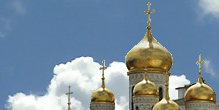 |
 |
|
|||
|
By Father Mieczysław Piotrowski TChr,
The Basilica of Our Lady in Saragossa is one of the most glorious Marian shrines in the world. It is a massive structure with four of the tallest bell towers in Spain and a central cupola surrounded by ten smaller ones, one of which bears the frescoes of Francisco Goya. The Holy Virgin of Pilar is the patroness of Spain and all countries sharing the Spanish language and culture.
The history of the Shrine dates back to the first half of the first century, when, shortly after the Ascension and the Descent of the Holy Spirit, the apostles set out into the world to spread the good news of Christ’s Resurrection. Tradition holds that it was Apostle James, known as “the Greater,” brother of John the Evangelist, who first arrived in the territories now known as Spain. As it turned out, his message to the inhabitants of the Iberian Peninsula fell on deaf ears.
On the evening of January 2, 40 AD, having succeeded in winning only eight disciples, James assembled his little group outside of the walls of the then Roman city of Saragossa on the right bank of the River Ebro, where the townsfolk used to dump their straw and rubbish. Discouraged by the apparent failure of his mission, he had decided to return to Palestine.
At that moment (tradition claims), a peculiar brightness appeared in the cold January night sky. Looking up, they saw a host of angels descending from heaven bearing a column upon which stood Our Blessed Mother. After they set the column down on the ground, Mary addressed the following words to James: “My son, this place has been marked out for my veneration. Thanks to you, a church shall be built here in my memory. Take care of this column on which I stand, for it is my Son and your Master who bade the angels bring it down from heaven. Next to this column you shall place the altar. Here, thanks to my prayers and intercession, the power of the Most High will work extraordinary signs and miracles, especially for those who call upon me in time of need. This column shall stand on this spot until the end of the world.” And so, around this column James built a small chapel, which came to be called Santa Capilla. (Today it stands inside the massive structure of the Shrine of Our Lady of Pilar).
A few years later, James suffered a martyr’s death in Jerusalem, but his mortal remains were returned to Spain where they were interred at Santiago de Compostela (Santiago being the Spanish name for Saint James.) Centuries later, the Christian knights who fought for Spain’s independence from the Muslims would relate how Saint James would appear on a white horse to lead their troops against the Muslim host. Only after 450 years of unremitting struggle did the Spaniards succeed in freeing themselves from Muslim rule. Ever since then, October 12 marks the date of the Shrine’s annual feast day commemorating the church’s consecration. Interestingly enough, it was also on October 12 that Christopher Columbus first set eyes on the shores of America.
A unique feature of the Pilar Shrine, setting it apart from other Marian sites, is the fact Our Lady was known to visit there not as an apparition but “in mortal guise” — that is, while she still walked this earth, living in Jerusalem. The sanctuary of the Holy Chapel houses the pillar (pilar) marking the place of Our Blessed Mother’s appearance on January 2, 40 AD. Made of jasper, plain and undecorated except for its silver plate covering, the column stands 177 cm tall with a diameter of 24 cm. The carved statue of the Madonna and Child, which stands atop it, is 38 cm high and is made of black wood. The column symbolizes the constancy of faith and serves as an eternal reminder of God’s mercy.
It is also worth noting that the miraculous restoration of Juan Miguel Pellicer’s amputated leg took place in 1640 — that is, exactly sixteen centuries after Our Lady’s appearance to the Apostle James and his eight disciples, and this also at night around the same hour.
The above article was published with permission from Miłujcie się! in November 2010
Read more Christian articles (English)
Recommend this page to your friend!
|
|